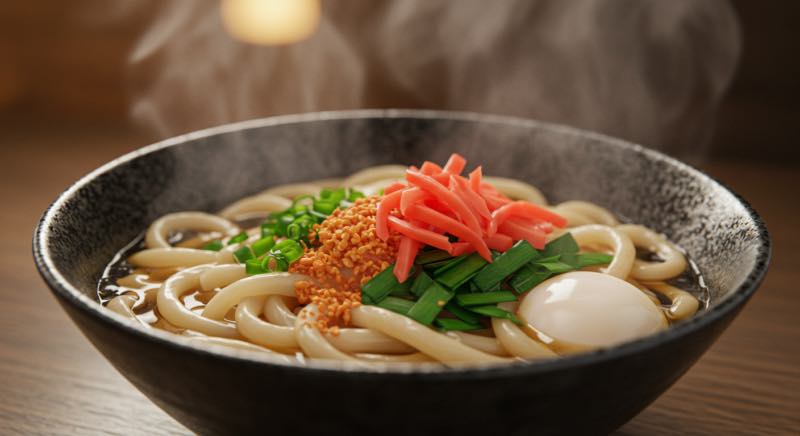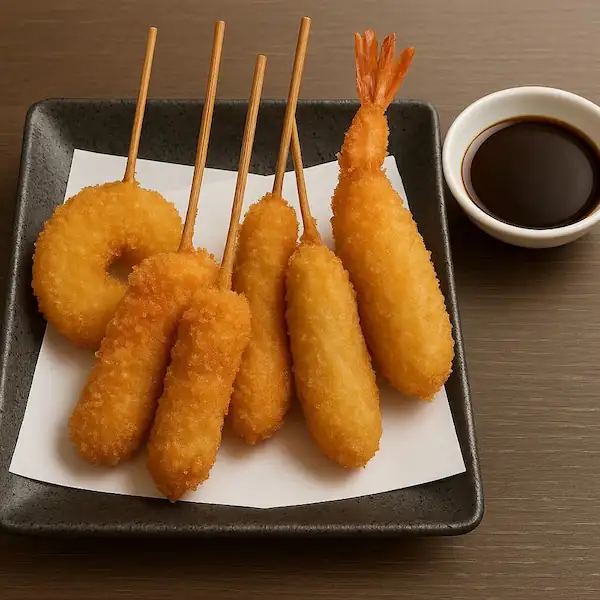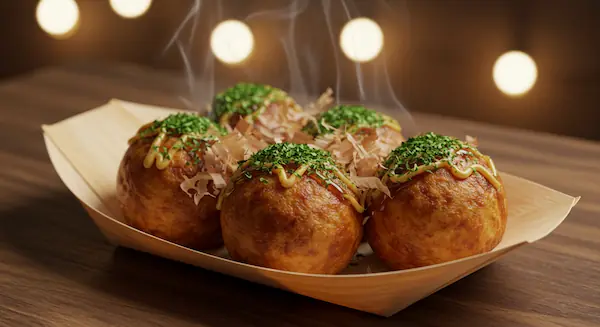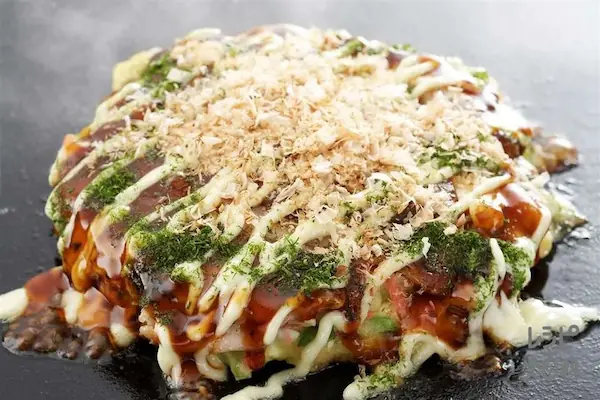Udon, Kushikatsu, Takoyaki, Okonomiyaki, and Seafood ramen: Osaka Food Guide
Welcome to Osaka, the “Nation’s Kitchen”! Are you feeling overwhelmed by all the delicious options in this “eat ’til you drop” city?
Don’t worry! This guide highlights five iconic Osaka foods that every first-time foreign visitor absolutely must try.
From comforting udon noodles and crispy kushikatsu to savory takoyaki and flavorful okonomiyaki, and even the unique seafood ramen, get ready for an unforgettable culinary adventure in Osaka!
Table of Contents
The nickname “Nation’s Kitchen” (tenka no daidokoro) dates back to the mid-Edo period when Osaka flourished as a major commercial hub.
A wide variety of ingredients, from Hokkaido kelp and wheat flour to salt, gathered here and were used to create dishes like udon.
This rich food culture continues to this day, captivating visitors.
The saying “eat ’til you drop” (kuidaore) perfectly describes the Osakan passion for food, where people are willing to spend generously to savor delicious meals. You’re guaranteed a satisfying food experience in this city!
1. Start with the Osaka Classic: Udon Noodles
Udon has a long history in Osaka, becoming popular among the common people as early as the mid-Edo period.
Osaka’s status as the “Nation’s Kitchen” meant easy access to high-quality ingredients like kelp from Hokkaido, excellent wheat flour, and salt, which supported the development of Osaka’s unique udon culture.
Records even show udon and soba shops near the “Sunaba”, a lumberyard in what is now Chuo-ku, Osaka, during the construction of Osaka Castle by Toyotomi Hideyoshi.
This suggests that noodle dishes were enjoyed in Osaka long before the Edo period, and over this long history, a distinct Osaka-style udon evolved.
Today, dishes like kitsune udon are beloved throughout Osaka Prefecture and are an essential part of the local diet.

1.1 Kitsune Udon: The Quintessential Osaka Flavor
When talking about Osaka udon, kitsune udon is a must-try.
It features sweet and savory simmered aburaage (deep-fried tofu pouches) that perfectly complements the flavorful broth, creating a truly Osakan taste.
The broth is typically made from kombu (kelp) and bonito flakes, and its rich aroma beautifully coats the chewy noodles, warming you from the inside out with every bite.
While there are various theories about its origin, the most widely accepted one points to Matsubaya (now Usamitei Matsubaya), an Osaka udon shop founded in 1893.
It’s said that a regular customer started adding the aburaage that came with the udon to their noodles, and the combination was so delicious that the shop began offering it as “kitsune udon.”
The name “kitsune” (fox) comes from the folklore that fried tofu is a favorite food of foxes, which are considered messengers of the gods and often offered fried tofu as a sacred offering.
Simple yet deeply satisfying, kitsune udon is truly a “soul food” for the people of Osaka, loved across generations.
1.2 Good to Know: Characteristics of Osaka Udon
Osaka-style udon has unique characteristics in both its broth and noodles.
The Kansai-style broth is light yet elegant, typically made with a base of kombu, bonito flakes, and sometimes dried sardines.
Light-colored soy sauce (usukuchi shoyu) is used to enhance the broth’s delicate flavor.
The noodles are generally softer and chewier compared to the very firm sanuki udon from Kagawa Prefecture. However, the thickness and shape of the noodles can vary between regions and shops, making it interesting to try different varieties.
In Osaka, besides udon with toppings like kitsune, the simple su udon, which is just noodles and broth with some green onions, is also common.
This reflects the Osakan appreciation for the pure taste of the broth and noodles themselves.
1.3 Enjoying the Authentic Taste: How to Eat Udon
The basic way to eat udon in Osaka is to slurp the noodles with chopsticks.
Slurping noodles is a unique Japanese eating custom and is often seen as a way to express enjoyment, so don’t feel self-conscious about it.
In fact, some people believe it enhances the flavor.
Also, be sure to savor the broth, as it’s full of flavor from the dashi.
Feel free to drink it all the way to the end to fully appreciate its depth.
Common condiments include chopped green onions and ginger, which you can add to your liking to change the flavor.
2. Crispy and Delicious: Osaka’s Staple Kushikatsu
Kushikatsu, deep-fried skewers, are an absolute must-try B-grade gourmet food in Osaka.
Various ingredients skewered, deep-fried to a golden crisp, and dipped in a sweet and savory sauce create an unforgettable taste.

2.1 Unraveling the History of Osaka Kushikatsu
The origin of Osaka kushikatsu is said to be in 1929 at a small restaurant called “Daruma” in Shinsekai, Naniwa-ku, Osaka.
The proprietress started deep-frying skewered meat for laborers.
Its affordability, deliciousness, and easy-to-eat format led to its explosive popularity, especially among post-war workers, and it became a staple of Osaka’s 庶民の味 (shomin no aji – common people’s food).
The original kushikatsu consisted of relatively inexpensive ingredients like beef, onions, and potatoes skewered and deep-fried, loved for its convenience and filling nature.
Today, Shinsekai is known as the “holy land of kushikatsu,” with numerous kushikatsu restaurants lining the streets.
2.2 The Allure of Variety in Kushikatsu
The appeal of kushikatsu lies in its wide variety of ingredients.
Not just beef, but also pork, chicken, seafood like shrimp and squid, vegetables such as eggplant, onions, and lotus root, and even unique options like cheese and mochi are skewered and deep-fried.
These ingredients are coated in a breadcrumb-based batter, giving them a delightful crispy texture that stimulates the appetite.
The classic way to eat freshly fried kushikatsu is by dipping it in a sweet and savory Worcestershire-like sauce.
However, some restaurants offer their own unique miso-based sauces, salt to enjoy the original flavor of the ingredients, or refreshing lemon juice.
Another characteristic of Osaka-style kushikatsu is that each skewer typically features only one type of ingredient.
2.3 Enjoying Kushikatsu the Right Way: Important Rules
There are a few important rules to follow when eating kushikatsu.
The most famous is “No double-dipping!” (sōsu no nidotsuke wa genkin!).
Re-dipping a skewer that has already touched your mouth into the communal sauce pot on the table is absolutely against etiquette for hygiene reasons.
If you need more sauce, the Osaka way is to use a piece of the accompanying cabbage to scoop up the sauce and drizzle it over your kushikatsu.
This cabbage is often free and refillable, so don’t hesitate to use it.
The basic way to eat kushikatsu is to eat it directly off the skewer without removing the ingredients.
Used skewers are typically placed in a container provided on the table.
In recent years, due to the COVID-19 pandemic, more restaurants are providing individual sauce bottles.
However, in establishments that maintain the traditional style, communal sauce pots are still used, so please be mindful of the etiquette and enjoy your meal.
You can also find kushikatsu in most izakaya (Japanese pubs), so be sure to try it if you visit one.
You can find more information about the pub here
- What Is an Izakaya? Exploring Japan’s Unique Pub (Bar) Culture
- What Are the 10 Must-Try Dishes at a Japanese Izakaya?
- What Are Popular Drinks in Japanese Izakayas? An Ultimate Guide
3. Hot and Gooey: Osaka’s Soul Food Takoyaki
Walking through the streets of Osaka, you’ll see takoyaki stands everywhere.
This is truly Osaka’s soul food.
The sight of hot takoyaki balls topped with dancing bonito flakes and green seaweed is enough to make your mouth water.

3.1 The Birth Story of Osaka Takoyaki
Takoyaki is said to have been invented in 1935 by Tomekichi Endo, a street vendor in Osaka.
Initially, the filling included beef and konnyaku (yam cake), but it evolved into its current form with octopus (tako) as the main ingredient, inspired by akashiyaki (a similar dish from Akashi).
After World War II, the style of eating it with sauce and mayonnaise became common, establishing it as a representative of Osaka’s konamon (flour-based food) culture, loved by locals and tourists alike.
3.2 The Basics and Secret to Deliciousness of Takoyaki
Takoyaki is made by pouring a wheat flour-based batter into special round-indented cast iron pans, adding chopped octopus, tenkasu (crispy tempura scraps), pickled ginger, and green onions into each indentation, and then carefully cooking them into round balls.
The appeal lies in the crispy exterior and the gooey, melty interior.
The batter is also infused with the flavor of dashi (broth), which enhances the overall taste.
Each shop has its own unique recipe for the batter, ingredients, and cooking method, so trying different vendors to find your favorite is part of the fun!
3.3 Enjoying Piping Hot Takoyaki: How to Eat
The best way to eat takoyaki is fresh off the grill, while it’s still piping hot. Be very careful of the heat! Generally, you use a bamboo skewer to pick up and eat each ball.
If it’s too hot to eat immediately, you can let it cool down a bit or use chopsticks or a skewer to break it open and let the steam escape.
Classic toppings include sweet and savory sauce, mayonnaise, aonori (green seaweed flakes), and bonito flakes, but some shops offer various unique toppings like cheese or kimchi.
4. Customize Your Own: Osaka’s Unique Okonomiyaki
Alongside takoyaki, okonomiyaki is another well-known Osaka soul food.
As its name suggests (“okonomi” means “to your liking”), the charm of okonomiyaki is that you can mix and cook your favorite ingredients into a savory pancake.

4.1 The History and Development of Osaka Okonomiyaki
The roots of okonomiyaki are said to be in a thin sweet cake called “funoyaki” that was offered at Buddhist ceremonies during the Edo period.
In the Meiji era, a sweet version called “sukesoyaki” appeared.
Later, during the post-World War II food shortage, okonomiyaki made with wheat flour became popular as an affordable and filling meal to replace rice.
Around this time, innovations like adding cabbage to increase volume brought it closer to its current form.
The name “okonomiyaki” came into use around the 1930s.
Its popularity spread nationwide after the 1970 Osaka Expo, and today it’s one of Japan’s representative dishes.
4.2 The Classic: Characteristics of Osaka Okonomiyaki
Osaka-style okonomiyaki is typically made by mixing cabbage, wheat flour, eggs, dashi (broth), and grated yam into a batter.
Popular classic ingredients include pork (especially pork belly), but you can also choose and add seafood like shrimp and squid, or any other ingredients you like.
Unlike Hiroshima-style okonomiyaki, where the batter and ingredients are layered, Osaka-style involves mixing everything together before grilling it on a griddle.
Once cooked, it’s usually topped with sweet and savory sauce, mayonnaise, aonori (green seaweed flakes), and bonito flakes.
The addition of yam to the batter gives it a fluffy texture, which is another characteristic of the Osaka style.
4.3 Enjoying Okonomiyaki Together: How to Eat
At specialized okonomiyaki restaurants, the staff often cook it for you on a griddle right in front of you.
Some restaurants also have griddles built into the tables where you can cook it yourself.
Once cooked, okonomiyaki is typically cut into pieces with a metal spatula called a “hera” and eaten directly off the spatula.
Of course, you can also use chopsticks and plates.
Sauce and mayonnaise are usually available on the table, so you can add more to your liking and create your own original flavor.
- Learn more about okonomiyaki: What is Okonomiyaki? Explaining the Deliciousness of an Osaka Specialty
5. Packed with Seafood Flavor: Seafood Ramen
In recent years, seafood ramen has been gaining attention in the world of ramen.
By adding seafood broth to animal-based soups like pork bone (tonkotsu) or chicken broth (torigara), it creates a deep and complex flavor that combines the rich umami of seafood with the savory depth of the animal broth.
5.1 Tasting Osaka: Characteristics of Seafood Ramen
In Osaka, you can enjoy ramen made with various types of seafood broth. Different kinds of seafood are used, such as kombu (kelp), dried sardines (niboshi), shellfish like clams, dried bonito and mackerel flakes, and even crustaceans like shrimp.
The soup is often soy sauce-based, but there are also salt-based and miso-based options.
Toppings include the standard chashu (braised pork), seaweed (nori), bamboo shoots (menma), and green onions, as well as the seafood itself.
The appeal of Osaka’s seafood ramen lies in the unique and creative bowls offered by each restaurant.
5.2 Where to Eat: Popular Seafood Ramen Shops in Osaka
Here are some popular seafood ramen shops in Osaka:
- Next Shikaku (Namba)
Known for its rich and flavorful Oyster Tsukemen (dipping noodles). - Kadoya Shokudo Sohonten (Nishinagahori)
Their classic chukasoba (Chinese-style noodles) with a perfect balance of chicken, pork, and seafood broth has been loved for years. - MENSTYLE TANIMOTOKE Hommachi (Hommachi)
Offers elegant ramen with a generous use of clam and other shellfish broth. - Resshishoyu Menkobo Sanku (Fukushima)
Famous for its impactful ramen with a strong dried sardine (niboshi) flavor. - Mugito Mensuke (Nakatsu)
Features a deep and complex flavor created by a double soup of chicken and seafood. - Moeyo Mensuke (Fukushima)
Another popular spot with a chicken and seafood double soup, where the chicken flavor is more prominent. - Ramen Hayato (Minamimorimachi)
Their soy sauce ramen with a double soup combining meat and seafood broth is a hit. - Gunjyo (Tenjinbashi)
Offers refined and delicate ramen made with duck, with subtle seafood notes.
Besides the five iconic dishes introduced here, Osaka has so much more delicious food to offer. Use this guide as a starting point and be sure to discover your own favorite “Osaka flavors.” Now, embark on your “eat ’til you drop” journey!

